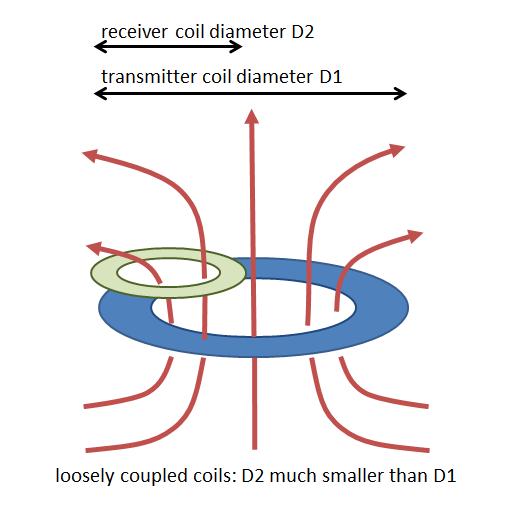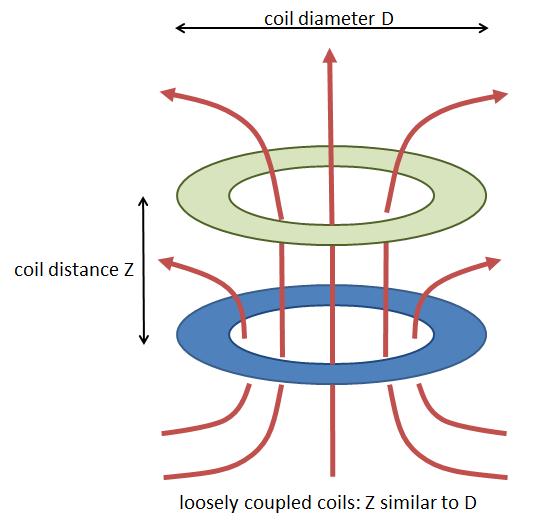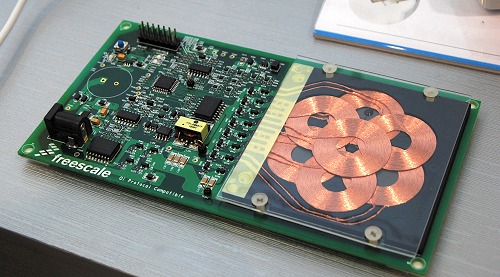The State of Wireless Charging Standards in Mobile
by Andrei Frumusanu on April 2, 2015 8:00 AM ESTInductive Coupling - The Basics
With the history of wireless charging out of the way, the remaining is question is how does it all work? To start, we need to understand the basics of inductive coupling.
Power transfer of inductive coupling happens by creating an alternating magnetic field on the transmitter coil, that magnetic flux is then converted into an electrical current in the receiver coil. The generated electrical current depends on the amount of flux generated by the transmitter coil, and how much of a percentage the receiver coil is able to capture. The distance, size, and positioning of the receiver coil relative to the transmitter coil decides the “coupling factor” of the two coils.
A higher coupling factor means a more efficient power transfer through loss reduction and less heating. In general, we differentiate between tightly coupled and loosely coupled systems.

Source: WPC
In tightly coupled systems, the transmitter and receiver coils both are of the same diameter size and aligned with each other with a minimal distance in-between them. This setup ensures most of the magnetic flux is captured by the receiver coil to be able to be converted into an electrical current.
Loosely coupled systems are defined by setups which do not capture all of the transmitter’s flux, either because the receiver coil distance is too big, or because the coil diameters don’t match and the receiver coil is smaller than the transmitter coil.


Source: WPC
While we mention loosely coupled systems and we’ll get back to them short when investigating Rezence charging, both WPC and PMA standards based on tightly coupled systems.
Optimal alignment of the transmitter to the receiver coil is crucial for a high coupling factor and high efficiency power transmission; because of this, there is a problem of practicality to actually achieve this alignment. To alleviate the issue, Qi transmitters allow for multiple transmitter coils that may overlap.

Source: WPC
By employing multiple transmitter coils over each other, we have a greater area of “optimal coupling” over which a device can be placed on. The control IC of the charging system will then detect which coil is best suited for the power transmission and then use that one for generating the magnetic flux. It is also possible to power on multiple coils simultaneously to achieve a higher power transfer if the receiver device is designed for it.
WPC & PMA Power Control
In Qi and PMA based systems, control over how the coils are powered is done via data communication between the transmitter and the receivers. This is done via data modulation (Either amplitude or frequency based) on the power carrier frequency. The in-band communication requires advanced signal processing and this is where manufacturers’ solution ICs come into play.
WPC wireless power functional diagram, Source: Texas Instruments
This communication is also the main difference and source of incompatibility between the Qi and PMA standards, as without a reliable and interoperable signal the charging process will not start. Powermat differs to Qi by using RFID handshake instead of modulation on the power signal.
The direction of power transfer is always from power transmitter to power receiver. The transmitter idles with in a low power state, which depending on vendor is in the 60mW range. When the power receiver detects a transmitter, it identifies itself to the transmitter as a compliant device and sends configuration information such as the desired charging power. Once power transfer is initiated, the receiver can send error packets requesting more or less power. The power transmission stops upon either receiving an “End Power” message or a period of non-communication of 1.25s.
The coils of a WPC-compliant device operate as resonant half-bridge on a 50% duty cycle with a 19V(±1V) DC power input. Depending on power demand, the frequency in the coil is modulated between 110 and 205 kHz. Powermat on the other hand works in the 277-357 kHz range.
On the receiver side, WPC gives the manufacturers much more liberty in terms of coil-design. While the transmitter is required to have a certain size and provide certain power for standard’s sake, the receiver is allowed to vary in size to adapt to the device form factor the system is implemented into.
Qi in its first low-power specification allows up to 5W of power transfer, with a revision on newer charging systems allowing up to 10W.
Unfortunately PMA does not publicize the standard’s specifications to non-members, so we don’t have any finer details on how it compares to Qi. It’s nevertheless safe to assume that the basic principles of the two standards work in similar fashion.











90 Comments
View All Comments
blanarahul - Thursday, April 2, 2015 - link
The biggest problem with wireless charging for me is significant power efficiency losses, additional heating up and hence reduced lifetime of smartphone batteries which can't be replaced, thicker phones and (not completely sure) slower charging. It's simply not worth the 2 seconds it takes to remove/insert the cord from the phone.Spoogie - Thursday, April 2, 2015 - link
But it's never really 2 seconds, is it.blanarahul - Thursday, April 2, 2015 - link
With Micro USB Type-C it will be. Short distance wireless charging is worthless to me. I'd rather have the extra space be spent on putting larger batteries.lilmoe - Thursday, April 2, 2015 - link
I think Spoogie meant that it's not only about "connecting" your charging cable (regardless of type). Taking out your charger and looking for a free socket can prove to be hassle.That said, I agree with you. I'd "prefer" simplifying the internal design of the device (making repairs easier) and installing a beefier battery instead of wireless charging. But having both does have its benefits.
My real problem with wireless charging on the go is that your device needs to be stationary, ie: you don't have the convenience of using your device semi-freely like you would when its tethered with a fairly long cable. It's only charging when you're generally not using the device, unless you have a bluetooth or wired headset. You "solve" an inconvenience just to be faced with others.
nathanddrews - Thursday, April 2, 2015 - link
We use wireless chargers mostly because the USB ports are failing (wear and tear). $20 Qi chargers are cheaper than new phones. I'll be happier once we get whole-home wireless power transmission.blanarahul - Thursday, April 2, 2015 - link
I can't wait to see the ridiculous SAR/(or it's wireless power equivalent) values wreak havoc on your nervous system when you switch to whole home wireless power.Lord of the Bored - Friday, April 3, 2015 - link
Spoilers: Those magnetic fields wireless power connectors use? The ones induced by alternating current flow through a wire? They're ALREADY being generated by every electrified wire in your home. If wireless power was going to fry your brains, we'd already be dead.(Tangentally, electromagnetic fields and RF radiation are fundamentally different beasts and not really comparable like that. Yes, I did look up SAR to figure out what the hey you were talking about.)
Fortunately, aside from it not actually being an issue, magnetic fields fall off rapidly with distance. That's why inductive power connections require very short distances. You may remember Apple used to use inductive power connectors on their laptops, and you still had to run a cable from the charger to the computer anyways.
Coincidentally, that falloff is ALSO why whole-house wireless power isn't likely to go anywhere. Since you have to run cords from your devices to your power outlets ANYWAYS, you may as well keep using the same dead-simple, cheap to manufacture "legacy" power connector you always have. It was a problem in Nikola Tesla's time, and it's a problem in our's as well. Physics is a real drag sometimes.
JonnyDough - Saturday, April 4, 2015 - link
Not only are we polluting ourselves with radiation, but other creatures such as bees are supposedly being interfered with as well. Cancer is at an all time high, despite the lowering of chemical pollutants in industry and fewer smokers.jospoortvliet - Sunday, April 5, 2015 - link
try using logic here for a sec. People die, right? I mean nobody can live forever. There is a bunch of things you can die off. Starting with war and murder, then bacterial, virus and parasitic infections. What happens if you eliminate most of that? The next in line becomes the most killing. Cancer. but in places with war and bad health care, there is still 'no Denver's because the other stuff kills people. despite them having mobile phones and electricity.As usual, conspiracy theories require actually more fantastic things to be true than reality... I'm sure there is a theory you have that explains all I said - but it will be nonsense.
omems - Saturday, April 11, 2015 - link
jospoortvliet is spot on. now that we're not dying from polio and the flu, we can die from heart disease and cancer. here's some actual data, excerpted from the NEJM.http://www.businessinsider.com/leading-causes-of-d...
if you have access, the original article has a good interactive chart that might be more intuitive.